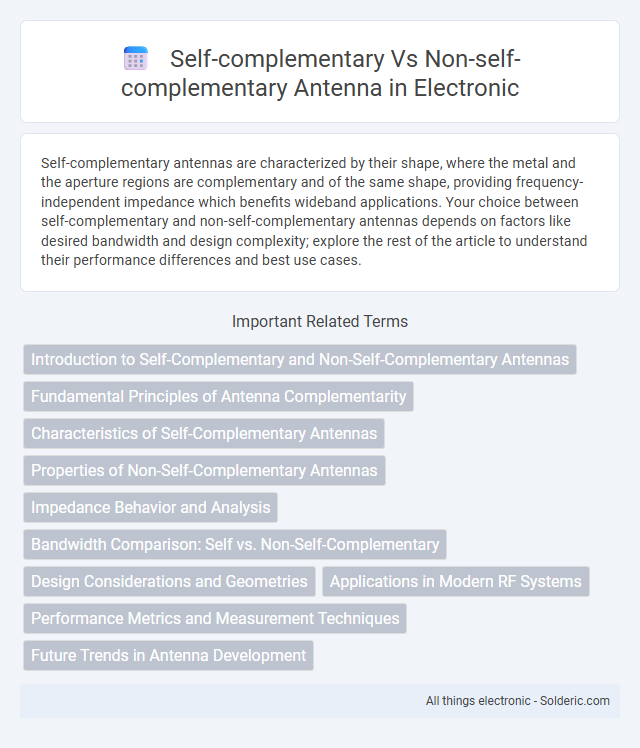Self-complementary antennas are characterized by their shape, where the metal and the aperture regions are complementary and of the same shape, providing frequency-independent impedance which benefits wideband applications. Your choice between self-complementary and non-self-complementary antennas depends on factors like desired bandwidth and design complexity; explore the rest of the article to understand their performance differences and best use cases.
Comparison Table
| Feature | Self-Complementary Antenna | Non-Self-Complementary Antenna |
|---|---|---|
| Impedance | Constant (~188.5 O), frequency-independent | Variable, frequency-dependent |
| Bandwidth | Ultra-wideband, very broad frequency range | Narrower bandwidth, limited frequency range |
| Design Complexity | Simple symmetrical structure | More complex, asymmetrical shapes possible |
| Radiation Pattern | Stable and predictable radiation pattern | Varies with design, less predictable |
| Size | Often compact due to self-complementary nature | Size varies, can be larger |
| Applications | Wideband communication systems, UWB antennas | Specific frequency applications, narrowband systems |
| Manufacturing | Requires precise symmetrical fabrication | More flexible manufacturing options |
Introduction to Self-Complementary and Non-Self-Complementary Antennas
Self-complementary antennas exhibit a unique geometric design where the shape of the antenna and its complement are identical, resulting in a constant input impedance over a wide frequency range. Non-self-complementary antennas lack this property, leading to frequency-dependent impedance and narrower bandwidth performance. The self-complementary principle, first introduced by Mushiake, provides antennas with inherently wideband characteristics crucial for modern broadband applications.
Fundamental Principles of Antenna Complementarity
Self-complementary antennas are designed based on the principle that the antenna and its complement occupy equal areas on a reference plane, resulting in frequency-independent input impedance. This principle ensures that the antenna's impedance is roughly constant over a wide frequency range, typically around 188.5 ohms, unlike non-self-complementary antennas, whose impedance varies significantly with frequency and structure. Understanding these fundamental differences allows you to select the appropriate antenna type for broadband applications requiring stable performance.
Characteristics of Self-Complementary Antennas
Self-complementary antennas exhibit a unique structure where their metal and aperture regions are identical in shape and size, resulting in frequency-independent input impedance near 188.5 ohms. Their broadband performance stems from this geometric self-similarity, making them ideal for ultra-wideband applications. These antennas maintain consistent radiation patterns and stable impedance across a wide frequency range, enhancing their versatility in RF communication systems.
Properties of Non-Self-Complementary Antennas
Non-self-complementary antennas exhibit distinct impedance characteristics, often requiring complex matching networks to achieve a wide bandwidth and optimal radiation efficiency. These antennas typically have a frequency-dependent input impedance that can vary significantly with geometric asymmetry, impacting their performance in broadband applications. Design flexibility is higher compared to self-complementary antennas, allowing tailored radiation patterns and polarization but often at the expense of bandwidth and simplicity.
Impedance Behavior and Analysis
Self-complementary antennas exhibit a constant impedance of approximately 188.5 ohms across a wide frequency range due to their unique geometry, simplifying impedance matching in your RF designs. In contrast, non-self-complementary antennas show frequency-dependent impedance variations that require careful tuning and complex matching networks to achieve optimal performance. Analyzing the impedance behavior reveals that self-complementary structures provide broadband characteristics, while non-self-complementary antennas often have narrowband impedance profiles influenced by shape and size.
Bandwidth Comparison: Self vs. Non-Self-Complementary
Self-complementary antennas inherently offer broader bandwidth due to their constant impedance characteristic, typically around 188.5 ohms, which minimizes reflection and signal loss across a wide frequency range. Non-self-complementary antennas, on the other hand, often exhibit narrower bandwidth as their impedance varies more significantly with frequency, requiring additional matching components to optimize performance. For your design, choosing a self-complementary antenna can simplify impedance matching and enhance broadband efficiency.
Design Considerations and Geometries
Self-complementary antennas feature a geometry where the metal and the open space are complementary shapes, enabling frequency-independent behavior and consistent impedance over a wide bandwidth, making them ideal for ultra-wideband applications. Non-self-complementary antennas rely on distinct conductive patterns without this complementary attribute, requiring careful impedance matching and tailored designs to achieve desired frequency responses. Design considerations for self-complementary antennas emphasize symmetrical sinuous or logarithmic spiral shapes, while non-self-complementary designs include dipoles, monopoles, and patch antennas with specific dimensions tuned for narrowband or broadband operation.
Applications in Modern RF Systems
Self-complementary antennas offer broadband performance and impedance matching that make them ideal for ultra-wideband communication, radar, and wireless sensor networks. Non-self-complementary antennas, with their tailored resonant frequencies, are preferred in applications requiring narrowband operation such as RFID, mobile handsets, and satellite communication. Your choice depends on whether your RF system prioritizes bandwidth versatility or frequency-specific efficiency.
Performance Metrics and Measurement Techniques
Self-complementary antennas exhibit constant impedance over a wide frequency range, resulting in stable VSWR and broad bandwidth compared to non-self-complementary antennas whose impedance varies significantly with frequency. Performance metrics such as radiation efficiency, gain, and return loss are typically measured using vector network analyzers (VNAs) and anechoic chambers to accurately capture the antenna's frequency response and radiation patterns. Time-domain reflectometry (TDR) and S-parameter measurements provide critical insights into impedance characteristics and signal integrity for both antenna types.
Future Trends in Antenna Development
Future trends in antenna development emphasize self-complementary antennas due to their broadband impedance characteristics and structural simplicity, enhancing multi-band and ultra-wideband wireless communication systems. Non-self-complementary antennas still play a crucial role in specialized applications requiring narrowband performance and compact design, but advancements in materials and fabrication are narrowing the performance gap. Emerging technologies, such as flexible electronics and metamaterials, are poised to further optimize self-complementary antenna designs for next-generation IoT, 5G, and beyond wireless networks.
self-complementary vs non-self-complementary antenna Infographic

 solderic.com
solderic.com